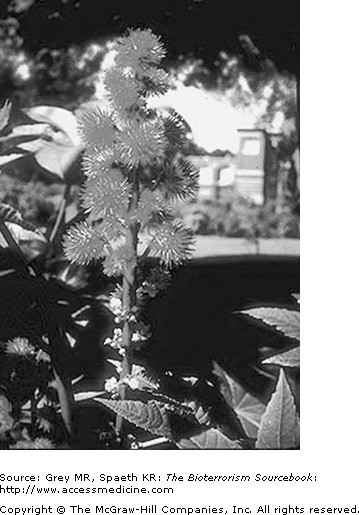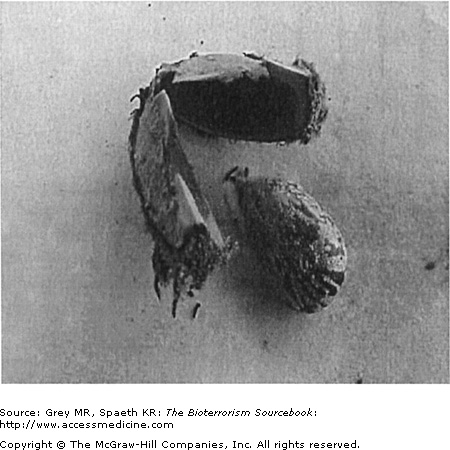Clinical Vignette
A 22-year-old with a history of allergic rhinitis and childhood asthma presents to your office for evaluation. He noticed a flulike illness with low-grade fever, congestion, watery itchy eyes, and dry cough 1 week earlier soon after he arrived at work. The symptoms resolved by midweek and he felt fine through the weekend. On Monday morning he noticed the same constellation of symptoms, but this time he developed hives and by midafternoon he felt quite short of breath. He works as a maintenance worker at a local manufacturer of castor oil for the automotive industry. His job involves removing the mash residual following processing of the castor plants. He has no significant cardiac history and is a nonsmoker. Because he was frankly wheezing and very dyspneic, you referred him to the local emergency room. You inform the ED that you suspect he may be having an allergic reaction to or even frank ricin intoxication from his work. As neither you nor the ED is familiar with this syndrome, you recommend that the attending contact the Poison Control Center regarding diagnostic testing and treatment.
Background
Ricin is a protein derived from Ricinus communis, a plant whose bean produces a natural laxative “castor oil” long known for its medicinal value and the bane of American school children through much of the 20th century. Ricin’s toxic properties were first identified in the 19th century. After castor oil is extracted from the bean, ricin remains in the residual mash and can easily be separated out. Ricin is not found in castor oil itself. Each year, approximately a million tons of castor beans are involved in industrial uses primarily to extract the oil for use as a lubricant in aerospace machinery. Such a figure represents an annual availability of 50,000 tons of industrial ricin byproduct and making it a viable BCN threat.
Ricin has played valuable roles both in the development of medical knowledge and as a therapeutic agent. At the end of the 19th century, experimentation with ricin laid the groundwork for understanding the mechanisms of immune response in regards to antibody stimulus and specificity. Ricin, owing to its antitumor effect, has been used as a chemotherapeutic agent. In recent years it has been of interest in the development of monoclonal antibodies in cancer treatment, as well as for treatment of chronic pain syndromes. Processing of castor plants industrially is also associated with occupational illness and disease. Castor bean dust or castor oil are organic compounds and may induce a typical allergic syndrome consisting of upper airway irritation, urticaria or rashes, and even reactive airways or frank asthma. Occupational exposure to plant mash also puts workers at risk for the toxic syndromes to be summarized in the following sections.
Ricin has a notorious history as a weapon of war and espionage as well. Ricin can be manufactured cheaply and easily, and it is a highly potent phytotoxin. Ricin first became of interest at the end of WWI when the American and British military recognized its potential as a military weapon. Efforts to create a ricin bomb were never completed. In 1978, it is believed that Soviet agents used a ricin pellet shot from an umbrella to assassinate Bulgarian dissident Georgi Markov in London. Ricin remains a concern as a terrorist weapon. In January 2003, the antiterrorist branch of Scotland Yard arrested six men of North African descent after small amounts of ricin were found in their apartment. In 2004, several federal buildings in Washington DC were evacuated when ricin powder was found in a letter to Senator Bill Frist. Ricin has also been reportedly found in some Al Qaeda and Ansar Al Islam caves in Afghanistan. These facts underscore the importance of understanding ricin and other biotoxins.
Properties
Ricin is a globular protein that comprises roughly 3% to 5% of the castor plant. Ricin is at its most potent if inhaled, but is also dangerous if ingested; however, skin contact appears to offer little to no risk. Chewing or swallowing as few as three to six castor beans may be fatal. Ricin can be made as a liquid, crystallized into a solid form or even into powder. Large-scale dissemination requires aerosolization of particles less than 5 microns. This is technically difficult, and for the present limits ricin’s usefulness as a mass terrorist threat or military weapon. Smaller scale use would likely involve contamination of food or water, points that could help in clinical decision-making.
Sources
Castor oil is used in a wide variety of industrial processes and is arguably one of the most important vegetable oils in terms of versatility and use. Castor oil is used in paints and varnishes, as a water-resistant treatment for fabrics, plastics, and metals. Its viscous and lubricating properties make it useful in the automotive industry, particularly as a high-performance engine motor oil and fuel additive. Castor oil is a raw ingredient used in the production of nylon and other synthetic fibers and resins. Its use for medicinal purposes is well known; less well known is its use in the perfume, flavoring, and odorant industries where it is incorporated into soaps, and synthetic fruit and flower scents. It is grown worldwide. Workers involved in the harvesting and processing of castor plants are at risk for toxicity if appropriate work practices are not followed. Workers involved in fertilizer manufacturing where pomace is used are also exposed to ricin, and dermatologic and allergic reactions have been described in this industry as well. Phytotoxins are an active area for medical research, a fact that increases potential sources for ricin and risk of injury to lab workers and scientists. Modified biotoxins that retain their immunogenicity with less neurotoxicity may prove useful in medical treatment for a wide variety of conditions, including cancers, and ricin inhibitors are being actively investigated for their potential use as an antidote.
Pathogenesis
Ricin’s toxicity is a result of its capacity to inhibit protein synthesis by stripping ribosomes of their purine bases, thereby slowing cellular protein production. It is classified as a ribosome inhibiting protein (RIP). One of its two polypeptide chains binds to a receptor on cell membranes and is brought into the cell via endocytosis. Once in the cell, the second polypeptide chain enzymatically cleaves RNA subunits thereby impairing protein synthesis and inducing cell death. A single ricin molecule is capable of incapacitating 1,500 ribosomes per minute making it one of the most potent cytotoxins known. The route and degree of ricin contamination determine where the toxin is likely to act and how it impacts the victim. With higher doses, particularly from ingestion of castor beans, splenic, hepatic, gastrointestinal, and renal necrosis can occur. This is thought to result from agglutination and hemolysis of red blood cells, rather than from direct insult to these organs.
Signs and Symptoms
The clinical presentation, including lab findings, varies according to the route and dose of exposure. In general, ricin causes direct endothelial toxicity leading to a vascular leak syndrome that accounts for most of its clinical effects.











